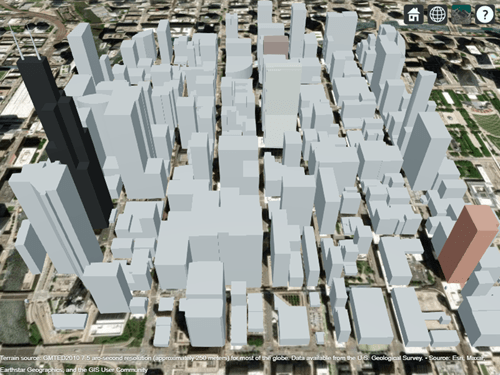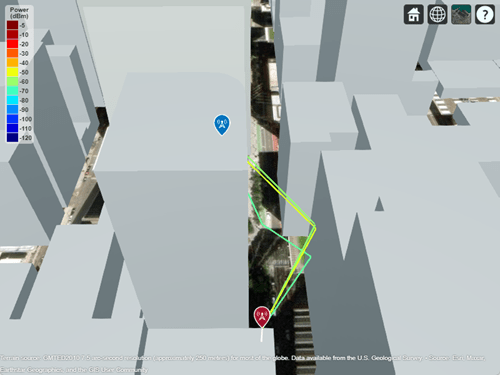sigstrength
Received signal strength
Description
ss = sigstrength(rx,tx,propmodel)PropagationModel name-value argument.
ss = sigstrength(___,Name=Value)Type="efield"
returns the signal strength in electric field strength units (dBμV/m).
Examples
Create a transmitter site.
tx = txsite(Name="Fenway Park", ... Latitude=42.3467, ... Longitude=-71.0972);
Create a receiver site with sensitivity defined in dBm.
rx = rxsite(Name="Bunker Hill Monument", ... Latitude=42.3763, ... Longitude=-71.0611, ... ReceiverSensitivity=-90);
Calculate the received power and link margin. Link margin is the difference between the receiver's sensitivity and the received power.
ss = sigstrength(rx,tx)
ss = -71.1414
margin = abs(rx.ReceiverSensitivity - ss)
margin = 18.8586
Launch Site Viewer with buildings in Chicago. For more information about the OpenStreetMap® file, see [1].
viewer = siteviewer(Buildings="chicago.osm");
Create a transmitter site on a building.
tx = txsite(Latitude=41.8800, ... Longitude=-87.6295, ... TransmitterFrequency=2.5e9);
Create a receiver site near another building.
rx = rxsite(Latitude=41.881352, ... Longitude=-87.629771, ... AntennaHeight=30);
Create a ray tracing propagation model, which MATLAB® represents using a RayTracing object. By default, the propagation model uses the SBR method and finds propagation paths with up to two surface reflections.
pm = propagationModel("raytracing");Calculate the signal strength using the receiver site, the transmitter site, and the propagation model.
ssTwoReflections = sigstrength(rx,tx,pm)
ssTwoReflections = -54.3151
Plot the propagation paths.
raytrace(tx,rx,pm)

Change the RayTracing object to find paths with up to 5 reflections. Then, recalculate the signal strength.
pm.MaxNumReflections = 5; ssFiveReflections = sigstrength(rx,tx,pm)
ssFiveReflections = -53.3965
By default, RayTracing objects use concrete terrain materials and building materials derived from the OpenStreetMap file. When the OpenStreetMap file does not specify materials, the model uses concrete. Change the building and terrain material types to model perfect electrical conductors.
pm.TerrainMaterial = "PEC"; pm.BuildingsMaterial = "PEC"; ssPerfect = sigstrength(rx,tx,pm)
ssPerfect = -38.9334
Plot the propagation paths for the updated propagation model.
raytrace(tx,rx,pm)

Appendix
[1] The OpenStreetMap file is downloaded from https://www.openstreetmap.org, which provides access to crowd-sourced map data all over the world. The data is licensed under the Open Data Commons Open Database License (ODbL), https://opendatacommons.org/licenses/odbl/.
Input Arguments
Receiver site, specified as an rxsite
object or an array of rxsite objects.
Transmitter site, specified as a txsite
object or an array of txsite objects.
Propagation model to use for the path loss calculations, specified as one of these options:
"freespace"— Free space propagation model"rain"— Rain propagation model"gas"— Gas propagation model"fog"— Fog propagation model"close-in"— Close-in propagation model"longley-rice"— Longley-Rice propagation model"tirem"— TIREM™ propagation model"raytracing"— Ray tracing propagation model that uses the shooting and bouncing rays (SBR) method. When you specify a ray tracing model as input, the function incorporates multipath interference by using a phasor sum.A propagation model created using the
propagationModelfunction. For example, you can create a ray tracing propagation model that uses the image method by specifyingpropagationModel("raytracing","Method","image").
The default value depends on the coordinate system used by the input sites.
| Coordinate System | Default propagation model value |
|---|---|
"geographic" |
|
"cartesian" |
|
Terrain propagation models, including "longley-rice" and
"tirem", are only supported for sites with a
CoordinateSystem value of
"geographic".
You can also specify the propagation model by using the
PropagationModel name-value pair argument.
Name-Value Arguments
Specify optional pairs of arguments as
Name1=Value1,...,NameN=ValueN, where Name is
the argument name and Value is the corresponding value.
Name-value arguments must appear after other arguments, but the order of the
pairs does not matter.
Example: sigstrength(rx,tx,Type="efield") returns the signal
strength in electric field strength units (dBμV/m).
Before R2021a, use commas to separate each name and value, and enclose
Name in quotes.
Example: sigstrength(rx,tx,"Type","efield") returns the signal
strength in electric field strength units (dBμV/m).
Type of signal strength to compute, specified as one of these options:
"power"— The signal strength is in power units (dBm) of the signal at the mobile receiver input."efield"— The signal strength is in electric field strength units (dBμV/m) of signal wave incident on the antenna.
Data Types: char | string
Propagation model to use for the path loss calculations, specified as one of these options:
"freespace"— Free space propagation model"rain"— Rain propagation model"gas"— Gas propagation model"fog"— Fog propagation model"close-in"— Close-in propagation model"longley-rice"— Longley-Rice propagation model"tirem"— TIREM propagation model"raytracing"— Ray tracing propagation model that uses the shooting and bouncing rays (SBR) method. When you specify a ray tracing model as input, the function incorporates multipath interference by using a phasor sum.A propagation model created using the
propagationModelfunction. For example, you can create a ray tracing propagation model that uses the image method by specifyingpropagationModel("raytracing","Method","image").
The default value depends on the coordinate system used by the input sites.
| Coordinate System | Default propagation model value |
|---|---|
"geographic" |
|
"cartesian" |
|
Terrain propagation models, including "longley-rice" and
"tirem", are only supported for sites with a
CoordinateSystem value of
"geographic".
Data Types: char | string
Map for visualization or surface data, specified as a siteviewer
object, a triangulation object, a string scalar, or a character vector.
Valid and default values depend on the coordinate system.
| Coordinate System | Valid map values | Default map value |
|---|---|---|
"geographic" |
|
|
"cartesian" |
|
|
a Alignment of boundaries and region labels are a presentation of the feature provided by the data vendors and do not imply endorsement by MathWorks®. | ||
In most cases, if you specify this argument as a value other than a siteviewer or
"none", then you must also specify an output argument.
Data Types: char | string
Output Arguments
Signal strength, returned as M-by-N array, where M is the number of transmitter sites and N is the number of receiver sites.
The units of ss depend on the value of the
Type name-value argument.
When you specify
Typeas"power", thenssis in power units (dBm) of the signal at the mobile receiver input.When you specify
Typeas"efield", thenssis in electric field strength units (dBμV/m) of signal wave incident on the antenna.
References
[1] International Telecommunications Union Radiocommunication Sector. Effects of Building Materials and Structures on Radiowave Propagation Above About 100MHz. Recommendation P.2040. ITU-R, approved August 23, 2023. https://www.itu.int/rec/R-REC-P.2040/en.
[2] International Telecommunications Union Radiocommunication Sector. Electrical Characteristics of the Surface of the Earth. Recommendation P.527. ITU-R, approved September 27, 2021. https://www.itu.int/rec/R-REC-P.527/en.
[3] Mohr, Peter J., Eite Tiesinga, David B. Newell, and Barry N. Taylor. “Codata Internationally Recommended 2022 Values of the Fundamental Physical Constants.” NIST, May 8, 2024. https://www.nist.gov/publications/codata-internationally-recommended-2022-values-fundamental-physical-constants.
Extended Capabilities
The sigstrength function supports ray
tracing analysis on a GPU with these usage notes and limitations:
The function runs on the GPU when you specify a
RayTracingpropagation model object as input and theUseGPUproperty of the object is"on"or"auto".For information about when the GPU can accelerate ray tracing analysis, see the
UseGPUproperty of theRayTracingobject.In some cases, the GPU and local CPU results can differ due to small differences in algorithms and hardware implementations.
For an example that shows how to perform ray tracing analysis on a GPU, see Accelerate Ray Tracing Analysis Using GPU.
Version History
Introduced in R2019bWhen calculating received power using ray tracing models, the
sigstrength function performs the ray tracing analysis
using additional materials. As a result of this change, depending on the materials
in the scene, the sigstrength function can return different
values in R2025a compared to previous releases.
When calculating received power using ray tracing models, the
sigstrength function uses improved algorithms and constant
values.
The SBR method uses additional edges in the scene as candidates for diffraction. As a result, the SBR method can find more rays in R2025a compared to previous releases.
When you specify transmitters and receivers that have polarized antennas from Antenna Toolbox™ or Phased Array System Toolbox™, the function calculates the phase shifts of rays using an improved algorithm that differently incorporates the far-field patterns of the antennas.
The function uses the constant values that are recommended by the 2022 Committee on Data of the International Science Council (CODATA) adjustment of fundamental constants [3]. In previous releases, the function used constant values from International Telecommunication Union Recommendations (ITU-R) P.2040 and P.527.
As a result of these changes, the sigstrength function can
return different values in R2025a compared to previous releases.
When calculating received power using ray tracing models, the
sigstrength function models materials using the methods and
equations in ITU-R P.2040-3 [1] and ITU-R P.527-5
through ITU-R P.527-6 [2].
In previous releases, the function used ITU-R P.2040-1. As a result of these
changes, the sigstrength function can return different values
in R2024a compared to previous releases.
The sigstrength function performs ray tracing analysis with multiple materials in the same scene when:
You create the scene from a glTF file, and specify the
propmodelinput argument as"raytracing"or aRayTracingpropagation model object with itsSurfaceMaterialproperty set to"auto"(the default).You create the scene from an OpenStreetMap® file or a geospatial table, and you specify the
propmodelinput argument as"raytracing"or aRayTracingpropagation model object with itsBuildingsMaterialproperty set to"auto"(the default).
The sigstrength function performs the ray tracing analysis using the
materials stored in the file or table. If the file or table does not specify materials, or
if the file or table specifies a material that the ray tracing analysis does not support,
then the function uses concrete instead of the absent or unsupported material.
As a result, the sigstrength function can return different values in
R2023b compared to previous releases. To avoid using the materials stored in the file or
table, create a RayTracing object (by using the propagationModel
function) and set its SurfaceMaterial property to
"plasterboard" and its BuildingsMaterial
property to "concrete". Then, use the object as input to the
sigstrength function.
The sigstrength function shows improved performance with complex scenes when you specify a RayTracing propagation model object that uses the shooting and bouncing rays (SBR) method as input.
The time that MATLAB® requires to perform ray tracing analysis depends on the scene and on the
properties of the RayTracing object, such as the
AngularSeparation, MaxNumDiffractions,
MaxNumReflections, MaxAbsolutePathLoss, and
MaxRelativePathLoss properties. In some cases, with moderate values
of the MaxAbsolutePathLoss and MaxRelativePathLoss
properties, the ray tracing analysis can be more than 2x faster in R2023b than in
R2023a.
Ray tracing propagation models discard propagation paths based on path loss
thresholds. By default, when you specify the propmodel input
argument as "raytracing" or a RayTracing
object, the propagation model discards paths that are more than 40 dB weaker than
the strongest path.
As a result, the sigstrength function can return different
values in R2023a compared to previous releases. To avoid discarding paths based on
relative path loss thresholds, create a RayTracing object (by using
the propagationModel function) and set its
MaxRelativePathLoss property to Inf.
Then, use the object as input to the sigstrength
function.
When calculating received power using ray tracing models, the
sigstrength function now considers multipath interference
by using a phasor sum. In previous releases, the function used a power sum. As a
result, the calculations in R2022b are more accurate than in previous
releases.
Starting in R2021b, when you use the sigstrength function and
specify the propmodel argument or
PropagationModel name-value argument as
"raytracing", the function uses the shooting and bouncing
rays (SBR) method and calculates up to two reflections. In previous releases, the
sigstrength function uses the image method and calculates
up to one reflection.
To calculate received signal strength using the image method instead, create a
propagation model by using the propagationModel function. Then, use the
sigstrength function with the propagation model as input.
This example shows how to update your
code.
pm = propagationModel("raytracing","Method","image"); ss = sigstrength(rx,tx,pm)
For information about the SBR and image methods, see Choose a Propagation Model.
Starting in R2021b, all RF Propagation functions use the SBR method by default and calculate up to two reflections. For more information, see Default modeling method is shooting and bouncing rays method.
MATLAB Command
You clicked a link that corresponds to this MATLAB command:
Run the command by entering it in the MATLAB Command Window. Web browsers do not support MATLAB commands.
选择网站
选择网站以获取翻译的可用内容,以及查看当地活动和优惠。根据您的位置,我们建议您选择:。
您也可以从以下列表中选择网站:
如何获得最佳网站性能
选择中国网站(中文或英文)以获得最佳网站性能。其他 MathWorks 国家/地区网站并未针对您所在位置的访问进行优化。
美洲
- América Latina (Español)
- Canada (English)
- United States (English)
欧洲
- Belgium (English)
- Denmark (English)
- Deutschland (Deutsch)
- España (Español)
- Finland (English)
- France (Français)
- Ireland (English)
- Italia (Italiano)
- Luxembourg (English)
- Netherlands (English)
- Norway (English)
- Österreich (Deutsch)
- Portugal (English)
- Sweden (English)
- Switzerland
- United Kingdom (English)